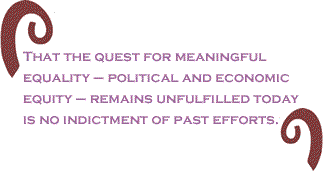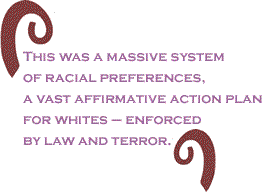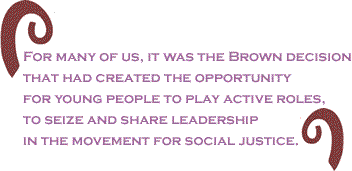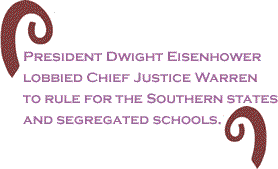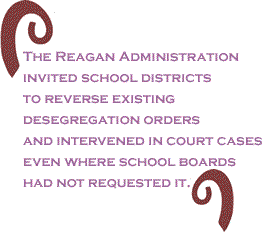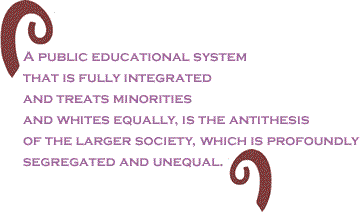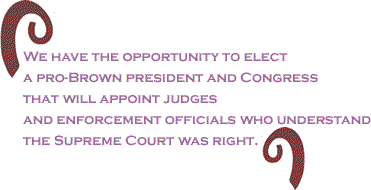
|
|||||||||||||||||||||
|
Prof. Bond delivered the following speech on May 15 in Topeka, Kansas, at the NAACP’s Brown commemoration. Fifty years ago this past April, Martin Luther King, Jr. preached his first sermon as the new pastor of Montgomery’s Dexter Avenue Baptist Church. He was twenty-five years old. One month later, on May 17th, 1954, the United States Supreme Court, in Brown v. Board of Education, unanimously declared that segregated schools violated the Constitution’s promise of equal protection. Two months later, on July 17, 1954, construction began at Disneyland. Sadly, today Brown’s promise is still lost in fantasy land. The Magic Kingdom remains closed to children of color in America. There can be no mistake – those fifty years since Brown have seen the fortunes of black America advance and retreat, but the decision is always cause for sober celebration, not impotent dismay.
We celebrate the brilliant legal minds who were the architects of Brown v. Board; we celebrate the brave families who were its plaintiffs; and we celebrate the legal principle that remains its enduring legacy – that, in the words of Chief Justice Earl Warren, "the doctrine of separate but equal has no place.” That the quest for meaningful equality – political and economic equity – remains unfulfilled today is no indictment of past efforts. It is testament to our challenge. As we commemorate the 50th anniversary of that landmark decision, it is easy to cast a cynical eye on the status of school desegregation in America today – or the sorry state of race relations – and minimize the significance of Brown. That is a grave mistake, for Brown, by destroying segregation’s legality, gave a nonviolent army the power to destroy segregation’s morality as well. Thus it is no coincidence that this year we also celebrate the 40th anniversary of the passage of the 1964 Civil Rights Act – the most sweeping civil rights legislation before or since, and our democracy’s finest hour. We look back on the years between Brown and the passage of the 1964 Civil Rights Act with some pride. In those years, Brown’s anniversary became a celebratory signpost, as major events focused on commemorating the date. The year after Brown, Rosa Parks sat down to stand up for her rights, and the Montgomery bus boycott began. Martin Luther King’s first national address was at a 1957 Prayer Pilgrimage on the third anniversary of Brown at the Lincoln Memorial. Later that same year the Little Rock Nine successfully integrated Little Rock’s Central High School.
Sit-ins at segregated lunch counters burst out across the South in 1960, followed by the Freedom Rides of 1961 and the forcible integration of Ole Miss in 1962. In 1963 alone, the year that King – fresh from the battlefields of Birmingham – told the nation of his dream at the March on Washington, there were more than 10,000 anti-racist demonstrations. King was the most famous and well known of the modern movement’s personalities, but it was a people’s movement. It produced leaders of its own; but it relied not on the noted but the nameless, not on the famous but the faceless. It didn’t wait for commands from afar to begin a campaign against injustice. It saw wrong and acted against it; it saw evil and brought it down.
Those were the days when good music was popular and popular music was good. Those were the days when the President picked the Supreme Court and not the other way around. Those were the days when we had a war on poverty, not a war on the poor. Those were the days when patriotism was a reason for open-eyed disobedience, not an excuse for blind allegiance. Those were the days when the news media really was “fair and balanced” and not just cheerleaders for the powerful. But those were not “the good old days.” Then, the American social order was rigidly stratified and racially codified. In those days, “[t]he law, the courts, the schools, and almost every institution … favored whites. This was white supremacy.”
Martin Luther King described it in 1962. He said then:
You would understand that most southern Blacks then could not vote. Most attended inadequate, segregated schools, if they went at all, and many attended only a few months each year. Most could not hope to gain an education beyond high school. Most worked as farmers, or semi-skilled laborers. Few owned the land they farmed, or even the homes in which they lived. This was a massive system of racial preferences, a vast affirmative action plan for whites – enforced by law and terror. It had one name and one aim – to crush the human development of a whole population. It began with slave-catching in Africa, and it continues on to the present day. Only by acknowledging the name, nature and scope of the problem can we measure the magnitude of our successes – and the costs of our failures. The day Brown was decided, the NAACP held a news conference to announce an ambitious new agenda. To Thurgood Marshall, Brown was the Magna Carta of black America, a declaration of our rights. School segregation would be eliminated, he thought, within five years. He was right about the former; he was obviously wrong about the latter. Within a year, in Brown II, the Supreme Court allowed desegregation to proceed “with all deliberate speed.” For the first time, the Court had declared a right and delayed its implementation. Three months after Brown II, Emmett Till, who was nearly my age, was murdered in Money, Mississippi, for whistling at a white woman. His death and the black newspapers that came into my Pennsylvania home created a great vulnerability and fear of all things southern in my teenaged mind. When my parents announced in 1957 that we were relocating to Atlanta, I was filled with dread.
Emmett Till’s death had frightened me. But in the fall of 1957 a group of black teenagers encouraged me to put that fear aside. These young people – the nine young women and men who integrated Central High School in Little Rock, Arkansas – set a high standard of grace and courage under fire as they dared the mobs who surrounded their school. Here, I thought, is what I hope I can be, if ever the chance comes my way. The chance to test and prove myself did come my way in 1960, as it came to thousands of other black high school and college students across the South. First through the sit-ins, then in Freedom Rides, and then in the voter registration and political organizing drives in the rural South, we joined an old movement against white supremacy that had deep, strong roots; for many of us, however, it was the recent Brown decision that had created the opportunity for young people to play active roles, to seize and share leadership in the movement for social justice. Brown was the movement’s greatest legal victory. It changed the legal status of black Americans, and ironically made challenges to the established movement’s narrow reliance on legal action possible. As Richard Kluger has written:
I believe in an integrated America – integrated jobs, homes and schools. I believe in it enough to have spent most of my life in its elusive pursuit. I think it is a legal, moral and political imperative for America – a matter of elemental justice, simple right waged against historical wrong. As Jack Greenberg, one of the attorneys for the Brown plaintiffs, put it:
And black and white. Brown was about black inequality, what Lyndon Johnson called “the one huge wrong of the American nation.” “The Supreme Court said nothing about Latinos until nineteen years after Brown and there never was any significant enforcement of desegregation for Latinos.” (See Orfield, Gary & Chungmei Lee, “Brown at 50: King’s Dream or Plessy’s Nightmare?”) Today, “U. S. schools are becoming more segregated in all regions for both African-American and Latino students.” By contrast, Asian students are the most integrated. I not only have spent most of my life in the cause of integration, in 1947 – when I was seven years old – I was a plaintiff in a lawsuit in rural Pennsylvania against segregated schools.
Last year I visited Berea College in Kentucky, opened by abolitionists as an integrated school in 1855. It was closed by the Civil War, but opened again in 1866 with 187 students – 96 blacks and 91 whites. It dared to provide a rare commodity in the former slave states: an education open to all - blacks and whites, women and men. One of those early students was my grandfather, James Bond. Like many others, I am the grandson of a slave. My grandfather was born in 1863, in Kentucky; freedom didn’t come for him until the 13th Amendment was ratified in 1865. He and his mother were property, like a horse or a chair. As a young girl, she had been given away as a wedding present to a new bride, and when that bride became pregnant, her husband – that’s my great-grandmother’s owner and master – exercised his right to take his wife’s slave as his mistress. That union produced two children, one of them my grandfather. At age 15, barely able to read and write, he hitched his tuition – a steer – to a rope and walked across Kentucky to Berea College and the college took him in. My grandfather belonged to a transcendent generation of black Americans, a generation born into slavery, a generation freed from servitude by the Civil War, a generation determined to make their way as free women and men. From Berea, he studied for the ministry, married, and had six children – one of them my father, Horace Mann Bond. My father graduated from Pennsylvania's Lincoln University and earned a doctorate in education from the University of Chicago. For him, too, education was a means to a larger end - the uplift of his people and the salvation of his race. How fitting, then, that he would be asked to help the NAACP in its legal campaign against school segregation - the campaign that culminated in Brown v. Board of Education. When Brown was before the Supreme Court, both its presenters and the Justices who heard it understood clearly its historic potential. In an unusual, but not unheard of procedure, the case – actually four cases combined, from Kansas, South Carolina, Virginia, and Delaware – was argued first in the 1952 term and reargued the next. A fifth case, from Washington, DC, was argued separately. Among other issues, the Court struggled with the meaning of the Fourteenth Amendment, that portion of the Constitution adopted after the Civil War, guaranteeing equal protection of the laws, as well as due process. In the earliest cases defining the Fourteenth Amendment, the Court had said:
From this hopeful beginning there emerged, only a few years later, the disgraceful doctrine of “separate but equal” in Plessy v. Ferguson.
In “laboring with the doctrine for over half a century” before Brown, the Supreme Court examined how “separate but equal” applied in a number of contexts, including education. But not until Brown was the continuing validity of the doctrine squarely presented. In scheduling Brown for re-argument, the Court asked the lawyers to prepare written responses to five questions, two of them dealing with the history of the Fourteenth Amendment and public education. The lawyers turned to historians and constitutional experts, including my father, for assistance. While C. Vann Woodward and John Hope Franklin were studying post-Reconstruction policies regarding race relations in the South and Alfred Kelley and Howard J. Graham were working on the intent of the framers of the Fourteenth Amendment, my father was researching the intentions of the ratifying states with respect to school segregation.
Perhaps, having done the right thing by denouncing "separate but equal", the Court then felt free to delay the implementation of what it had announced. Whatever the reason, the phrase "with all deliberate speed" was added to the lexicon of ignominious judicial pronouncements less than a year after one of the most shameful judicial doctrines had been discarded.
The Court, a year after announcing its decision on the merits, ordered the nation to make haste slowly in desegregating the system of separate and unequal schools. The defendants were required, in a masterpiece of ambiguity, "to admit to public schools on a racially nondiscriminatory basis with all deliberate speed the parties in these cases. " For the first ten years after Brown, the emphasis was more on "deliberate" than on "speed." The focus was on dismantling the dual school systems in the South, the products of de jure segregation, and in southern accents, all deliberate speed meant any conceivable delay. Actual integration was more a legal fiction than fact. President Dwight Eisenhower had lobbied Chief Justice Warren to rule for the Southern states and segregated schools; he never endorsed the Brown decision, and the resistant white South, emboldened by his rectitude, reacted with evasion and delay. Their tactics included violence, expansion of private schools, state support for fleeing white students, proposals to abolish public education, repeal of compulsory attendance laws, and the long discarded theories of interposition and nullification. Prince Edward County, Virginia, simply closed its public schools for five years, believing that uneducated children were preferable to integrated ones. Where massive resistance failed, aggressive resistance succeeded. By the end of 1964, ten years after Brown, more than 97% of all Southern black children still attended segregated schools. There was far too much deliberation and far too little speed. When the ’64 Civil Rights Act was being debated and finally became law, most in the civil rights community concentrated on the public accommodations section of the Act – on lunch counters and restaurants, and on provisions affecting employment discrimination. Overlooked, for many, were provisions of the Act dealing with education, and overlooked today is how important the Act could have been in making Brown’s promise a reality. When Congress was debating the 1964 Civil Rights Act, in all of Alabama, only 29 black students attended formerly white schools, only 9 in South Carolina, and none in Mississippi. The four years following the passage of the Civil Rights Act of 1964 represent the only period in the 50-year-history of Brown when there was active support for desegregation from both the executive branch and the courts. For the first time, under a southern President, Lyndon Johnson, the Federal government began to take an active role. This period saw the percentage of black children in school with white ones more than quadrupled, rising from 3 to 13%. But still there were costs. Surrendering to caution, the integration process became a one-way street as a few black students and fewer black teachers and even fewer administrators were admitted to formerly all-white schools. Thousands of black schoolteachers lost their jobs as black and white schools merged. Lost too was history – revered school names, mottoes, mascots, traditions. Plaques, trophy cases, school colors – all the artifacts that honored black achievement disappeared. Black students found themselves in formerly all-white school buildings that retained the character and identity acquired in the segregated past – Booker T. Washington High School vanished; Robert E. Lee High School persevered. In President Lyndon Johnson's last year in office, the federal government reviewed 28 communities for compliance with desegregation guidelines; in President Richard Nixon's first year, the figure dropped to 16. By the second year it stood at 15; the third year at 11; the fourth year at 9; the first year of his second term at 1, and by the next year, the number dropped to none. The years 1968-73, however, represent the most active period of Supreme Court intervention on behalf of school desegregation. The court that 13 years earlier had been content to see desegregation proceed “with all deliberate speed” ordered segregation removed “root and branch” in 1968.To that end, it permitted busing in 1971. Johnson’s commitment to civil rights had sustained enforcement efforts in the South in the face of widespread white opposition. When Republicans captured the White House, the process was politicized, and the principle sanction available to enforce desegregation, cutting off federal funds, was renounced.
Within months of Nixon’s election, what was then known as the Department of Health, Education and Welfare (HEW) was under orders to end the threat of funding cut-offs as a prod to integration; enforcement was transferred from HEW to the Department of Justice, which under Attorney General John Mitchell, argued in the Supreme Court for less desegregation, not more, establishing a pattern adopted by the Ford, Reagan, and Bush Administrations. Nixon’s HEW Secretary took the extraordinary steps of writing to the Fifth Circuit Court of Appeals to say that desegregation plans prepared by his own department’s experts form Mississippi would cause “chaos, confusion, and catastrophic educational setbacks.” The Carter Administration attempted to revive fund cutoff enforcement. Cut-off action was begun in Kansas City. But the only limiting amendment adopted by Congress to the ’64 Civil Rights Act was pushed by liberal Democrats Thomas Eagleton of Missouri and Joseph Biden of Delaware, when schools in their home states faced desegregation efforts. The Reagan Administration launched an attack on school desegregation. They invited school districts to reverse existing desegregation orders and intervened in court cases even where school boards had not requested it. They asked the Supreme Court to authorize tax exemptions for private segregated schools. They settled cases with remedies that had failed elsewhere. They eliminated the major desegregation aid program. What distinguished the Administrations of Ronald Reagan and George H. W. Bush was their attacks on virtually all components affecting segregation and discrimination in American education. After passage of the 1964 Civil Rights Act, the first President Bush, then a House member, told his fellow Texans, “The new Civil Rights Act was passed to protect 14% of the people. I’m worried about the other 86%.” The percentage of black students at majority white schools in the South went from zero in 1954 to a peak of 43.5 percent in 1988, proving there is nothing wrong with Brown’s premise. It is Brown’s promise that has been broken – betrayed by a failure of Presidential leadership, defeated by a lack of Congressional oversight and action, ruined by a retreat by the federal bureaucracy charged with enforcement, and crushed by a series of unfavorable court rulings, ranging from the adverse to the hostile. When William Rehnquist joined the Supreme Court, courtesy of Richard Nixon, all major desegregation cases since Brown had been unanimous. Rehnquist, as a clerk to Justice Jackson during the Brown case, had written a memo arguing that the Court should uphold Plessy v. Ferguson. Then he lied about it at his confirmation hearing. As a Justice himself, Rehnquist cast the first dissenting vote in a post-Brown desegregation case in 1973, setting the stage for what would become a new anti-desegregation majority in the 1990s after he became Chief Justice. So today we have a Chief Justice who has consistently opposed school desegregation and an Attorney General who built his political career on attacking the efforts of the federal courts to desegregate St. Louis and Kansas City schools. As Missouri’s Attorney General and then Governor, John Ashcroft continually attacked the federal courts managing school integration in his state and, when the courts found the state to be “the primary constitutional violator,” he fought to limit the state’s contribution to the remedy the court imposed.
It is hardly a surprise, then, that when the current state of school integration is examined, discouraging results abound. If the years since Brown have not succeeded in dismantling segregated schools, those years have seen American preferences for segregated education shrink. That constitutes modest achievement for black Americans. For us and other minorities, separate has never been equal, not then, not now. America’s history tells us that has always been true. There are few matters on which experts in any given field agree. Educational experts, however, agree that no school district in America has managed to create equal education on a large scale in segregated schools, be they black or Hispanic schools. This is not to say that one-race schools are never successful. A few are – particularly on the elementary level. But the bottom line is that students who attend schools that are segregated by race and income consistently rank lower in educational achievement, especially at the secondary school level. In short, the United States can't afford separate schools. The educational damage done by racial segregation does not grow from the relationship between blacks and whites alone; it grows from the relationship between blacks and whites and green. In America, the education dollar follows the white child. The students who are most likely to find themselves in schools of concentrated poverty today are not white; they are black and Latino. Compared with poor whites, poor blacks are more likely to live in neighborhoods where a high percentage of the residents are poor. They interact mainly with others who are poor, who share their disadvantage. They live, squeezed together, in less than standard housing, in neighborhoods denuded of essential services. They shop at stores owned by merchants geared to do business with a poor clientele. Their neighborhoods are economically and racially segregated, bereft of opportunity, out of sight and out of mind. Their children attend schools only with other poor, minority children. As the New Jersey Supreme Court said, “They face, through no fault of their own, a life of poverty and isolation that most of us cannot begin to understand and appreciate.” Fewer dollars in the parents' pockets mean fewer dollars in the school board's treasury. Children in high poverty schools read less, get lower grades, and miss more days of school. Economic and racial integration are preconditions for equal opportunity. Once achieved, they permanently alter the pattern of minority-majority relationships. In cities where school integration exists, it is not only the most visible form of desegregation, but the only one that impacts personally on the lives of millions of whites. This is why whites have so strongly resisted it; it is also why blacks and other minorities must continue to insist upon it.
I recently heard Minnie Jean Brown reflect on her experiences as one of the heroic Little Rock Nine who integrated Central High School in 1957. Someone asked why she kept coming back to school day after day, despite daily harassment and intimidation that would have driven most people away. From the ferocity of her enemies, she said, “I knew there was something precious inside that school,” and she was more determined to get it than they were to keep it from her grasp. There are those who scoff at Brown as if the advantages to black children were to be gained simply by sitting next to white ones in a classroom, as if a skin-to-skin transfer of knowledge and education could occur. These critics miss the point of integrated schools. They are, as one expert said, "truly radical.” A public educational system that is fully integrated and treats minorities and whites equally, is the antithesis of the larger society, which is profoundly segregated and unequal. The goal of putting minorities and whites in the same classrooms is not only to equalize education, but also to change the formative racial experiences of the next generation. Today minority children face inequalities in school spending, and more – they face what Jonathan Kozol calls “punitive testing and accountability agendas” imposed by the No Child Left Behind Act. Schools have adopted a “grill and drill curriculum” that substitutes learning by rote and teaching to the test for the transmission of critical thinking from teacher to pupil. Our schools present two faces to American society. In one, they are our most important democratic institution, pathways to class mobility and generational progress, and their success or failure impacts the lives and prospects of millions of families and children every day. The other face is an instrument for reproducing the class and race privilege of the larger society, reinforcing the very inequality they are designed to overcome. On our present course, we are formalizing two school systems: one filled with middle class children, most of them white, and one filled with low-income minorities. For too many, the latter schools have become a conveyor belt to prison. Our future as a nation depends on our willingness to continue to reach into the racial cleavage that define American society and change the racial contours of our world.
In 1954, the Federal government’s brief in Brown argued that school desegregation was a Cold War imperative, a necessary weapon to win America’s battles overseas. Current events give us the same imperative – to prove to enemy and ally alike that our commitment to justice is sincere. What, then, is to be done? Do we continue to slide backward toward Plessy and segregation, or can we make Brown’s promise at last come true? The brave Americans who fought and won Brown fifty years ago faced obstacles we cannot imagine and had few resources and little public support with which to do the job. We can do no less. This fall, we have the opportunity to elect a pro-Brown president and Congress that will appoint judges and enforcement officials who understand the Supreme Court was right then and that the job is far from over. We can revive the federal aid program of the Nixon and Carter Administrations that helped multiracial schools deal positively with issues of race relations, multicultural curricula, and more effective classroom operation. We can recruit young people, especially young people of color, into the education profession, and insure they receive full and fair employment opportunities from all school districts, not just minority schools. We can mount a real fight against housing segregation, and insure minority parents and their children have access to middle class schools. We can use choice programs – magnet and charter schools – if they are enacted in a strict pro-integration mode, forbidding transfers that increase segregation and rewarding those that diminish it. We can amend the No Child Left Behind Act and provide financial incentives and positive recognition to segregated suburbs that accept significant numbers of minority students from failing schools. When my grandfather graduated from Berea, he was asked to deliver the commencement address. He said then:
“Greater efforts and grander victories.” That was the promise made by the generation born in slavery a century and a half ago. That was the promise made by the generation that won the great World War for democracy six decades ago. That was the promise made by the generation that brought democracy to America’s darkest corners four decades ago, and that is the promise we must all seek to honor today. Julian Bond is a Distinguished Professor at the American University in Washington, DC, and a Professor in History at the University of Virginia. Since 1998, he has been Board Chairman of the NAACP. Copyright 2004 by Julian Bond |
May
20 2004 |
|||||||||
|
|||||||||
|
|
|||||||||
| Printer Friendly Version | |||||||||
 |
|||||||||
| |
|||||||||
| |
|||||||||






















